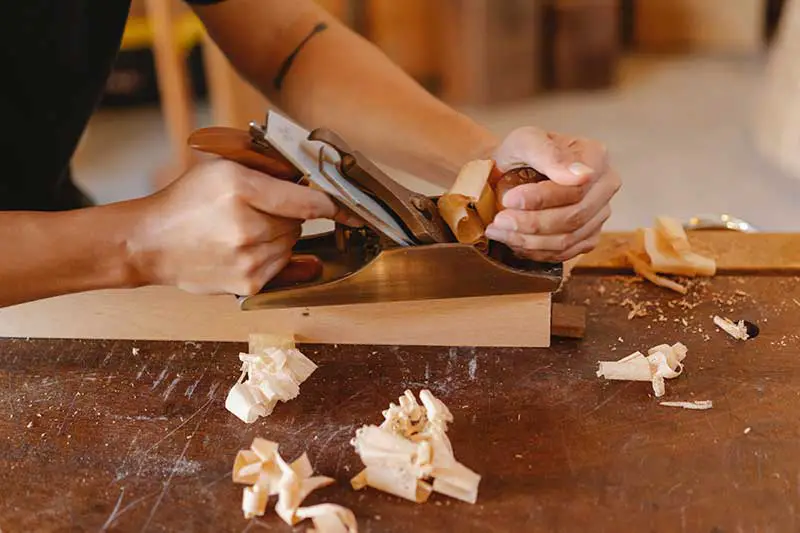Sharpening planer blades involves removing them from the planer, flattening the backs, and honing the bevel using sharpening stones or a honing guide.
Why Sharpening Planer Blades is Important
Sharpening planer blades is essential to maintain the performance and quality of your planer. Dull blades can result in rough, uneven cuts, increased tear-out, and excessive strain on the planer motor. Regular sharpening ensures clean, precise cuts and extends the life of both the blades and the planer.
“Maintaining sharp planer blades is crucial for optimal performance and achieving smooth, even cuts in your woodworking projects.”

Types of Planer Blades
There are several types of planer blades, each with unique characteristics and sharpening requirements:
- High-speed steel (HSS) blades: These blades are made from high-quality steel, known for their durability and ability to hold an edge. HSS blades are commonly found in handheld and benchtop planers.
- Carbide blades: Carbide blades are made from a tungsten carbide material, which is significantly harder than HSS. These blades tend to stay sharp longer but can be more difficult to sharpen and more expensive to replace.
- Disposable blades: Some planers use disposable blades, which are designed for single-use and are not intended for sharpening. Instead, they are simply replaced when they become dull.
Tools and Equipment Needed for Sharpening Planer Blades
To sharpen planer blades, you will need the following tools and equipment:
- Sharpening stone or water stone: A sharpening stone or water stone is used to sharpen the blades. These stones are available in various grits, from coarse to fine, depending on the level of sharpening required.
- Honing guide (optional): A honing guide helps maintain the correct angle when sharpening the blades. This can be particularly useful for beginners or those who are not confident in maintaining a consistent angle by hand.
- Blade removal tools: Depending on the type of planer and blade system, you may need specific tools to remove the blades, such as an Allen wrench, screwdriver, or specialized blade removal tool.
- Ruler or straight edge: A ruler or straight edge is used to check the flatness of the blade after sharpening.
Step-by-Step Guide to Sharpening Planer Blades
- Remove the blades from the planer: Unplug the planer and carefully remove the blades according to the manufacturer’s instructions.
- Inspect the blades: Examine the blades for damage or excessive wear. If the blades are damaged or worn beyond repair, they should be replaced rather than sharpened.
- Clean the blades: Wipe away any dust, debris, or residue from the blades using a cloth or brush.
- Prepare the sharpening stone: If using a water stone, soak it in water for about 10-15 minutes before sharpening.
- Sharpen the blades: Starting with a coarse grit stone, hold the blade at the correct angle (typically 30-45 degrees) and slide it across the stone in a back-and-forth motion. Ensure that the entire edge of the blade comes into contact with the stone. Repeat this process using progressively finer grit stones to refine the edge.
- Check the blade flatness: Place the blade on a flat surface, such as a ruler or straight edge, to check its flatness. If the blade is not flat, continue sharpening until the entire edge is uniform.
- Hone the blades (optional): If desired, use a honing guide and a fine grit stone to further refine the edge and ensure a razor-sharp finish.
- Reinstall the blades: Once the blades have been sharpened, carefully reinstall them in the planer, following the manufacturer’s instructions. Ensure that the blades are properly seated and secured before using the planer again.
- Test the planer: Plug the planer back in and perform a test cut on a scrap piece of wood to ensure the blades are sharp and properly installed. The planer should produce a smooth, even cut with minimal effort.
“Sharpening your planer blades is an essential maintenance task that keeps your planer performing at its best and ensures the highest quality cuts in your woodworking projects.”
Key Takeaways
- Sharpening planer blades is essential for maintaining the performance and quality of your planer.
- There are different types of planer blades, including HSS, carbide, and disposable blades.
- Tools and equipment needed for sharpening include sharpening stones, honing guides (optional), blade removal tools, and a ruler or straight edge.
- Following a step-by-step guide to sharpening planer blades ensures the proper angle, sharpness, and flatness of the blades.
